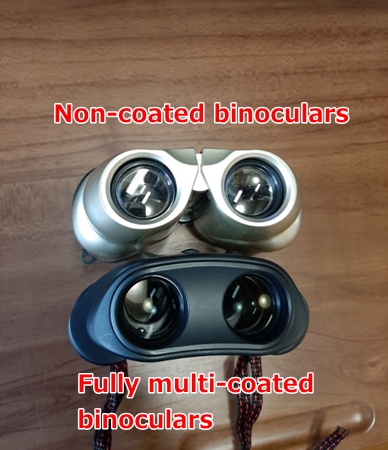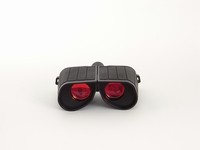When people walk by large windows, they sometimes stop to look at their reflections. Large windows are like big public mirrors.
How does this work? Window glass is mostly transparent, but not all of the light passes through.
Some of the light reflects back from the surface, which is good if you want to straighten your clothes or fix your hair.
In optical lenses, however, the reflection means a loss of light, which will make an image dimmer. In this article, I will explain why anti-reflective coatings are necessary and how they work to bring you a brighter image.
Contents
Why anti-reflection coatings are necessary
Optical glasses are enhanced for maximum clarity, but they still reflect light. Here’s how they work.

When light passes through a lens, about 4% of the light gets reflected on the front surface. Also, it loses 4% of the light again on the rear surface, which means only 92% of the light can pass through a single lens (see above).
This loss of light would be a big problem for binoculars because each barrel has at least ten lenses and two prisms.
Every time light passes through these lenses and prisms, 4% of the light is lost. When the light finally reaches your eyes, it’s only about half as bright.
How anti-reflective coatings work
Without lens coatings, not only is the amount of light greatly reduced, but also the reflected light will have a negative effect on the contrast of the image.
Because of this, anti-reflective coatings are applied to good quality binoculars to improve light transmission.
To help you understand, here is the physics behind the light transmission and lens coatings.

When light passes through a coated lens, it reflects on the surface of the coating (the red arrow), and it reflects again on the front surface of the lens (the blue arrow).
When these two reflections meet, interference of light (Destructive Interference of Light) occurs. As a result, changing the direction, this reflected light passes through the coated lens in accordance with the Law of Energy Conservation (the green arrow).
This is to minimize reflection and improve light transmittance.


Using carefully selected material so that destructive interference occurs effectively, manufacturers vaporize the material to coat the lenses.

These photos show how they coat the lenses at the factory in China.
For the past three decades, there has not been much innovation in the optical design of binoculars. However, the light transmittance has dramatically improved thanks to the development of antireflective coating techniques.
There are a few different grades of coatings. Here, we’ll talk about each grade.
The level of anti-reflective coating
When you look at the specifications of binoculars, you’ll find terms such as ‘Multi-Coated’ or ‘Fully Multi-Coated.’ These refer to the grade of coatings applied to the lenses.
As you may know, what we perceive as light is a small portion of the electromagnetic spectrum visible to humans. Visible light has a wavelength of 420-680nm.

- Single-layer-coating
Single-layer coating works on some visible light, but not enough. Looking through the binoculars with single-layer coating, you’ll notice that the color takes on a shifted hue.
- Multilayer-coating
Multilayer coatings are applied to today’s better binoculars so that a wide range of visible light can pass through the lenses and prisms.
In short, the more layers of coating, the wider range of colors can pass through the lenses, which leads to a higher light transmittance.
- Fully multi-Coated
Many binoculars feature fully multi-coated lenses. What does this mean?
It means that all lens surfaces are coated with multi-layer coatings. In some cases, even the surfaces of the prisms are coated as well.
In Hinode’s discontinued compact binoculars, Hinode S1 6×21, all lens surfaces and prisms are fully multi-coated to improve light transmittance to the utmost.
Combined with a simple optical design, the nine layers of fully multi-coated lenses enable us to get a crystal clear view.
The chart below shows how effectively visible light passes through the Hinode S1 6×21. This light transmittance is as high as more expensive binoculars’.
Some binoculars also have an extra coat: water-repellant coating. Water and dirt roll off the surface of the glass, making it easy to keep the lenses clean.

A few drops of alcohol on the objective lenses. The alcohol spreads on regular coating (left). The drops stay together on water-repellent coating (right).
Ruby coated lenses: the worst choice.
On the Internet, you find some binoculars have flashy red or orange coated objective lenses, which is called ‘Ruby coating.’

On the Internet, it’s common to find binoculars with flashy red or orange coated objective lenses, which is called ‘Ruby coating.’
Binoculars touted as ‘Ruby-coated,’ do not make any sense.
For one thing, the ruby coating does not improve light transmittance. To make matters worse, it ruins the color balance of the image because it eliminates red light.
Some people still believe that the ruby coating can protect their eyes from infrared light. However, the regular (non-ruby) coated binoculars are designed to only let visible light pass through.
In conclusion, you should not get ruby-coated binoculars.
Summary
When light passes through a lens, the volume of light is reduced because of reflection. In binoculars, with over ten lenses and prisms, this would mean a lot of lost light.
Coatings are applied to good quality binoculars to improve the light transmittance. There are a few different levels and grades of lens coatings.
As the number of layers of coatings increases, the light transmittance improves resulting in a brighter image. Also, fully-multi coated binoculars enable us to get a true-color image.
Ruby-coated binoculars, claiming to protect your eyes from infrared light, are inferior products. Do not be deceived.
With well-made binoculars such as Swarovski, Zeiss, and Leica, the image is crystal clear. Lens coatings play an important role in improving the image you get with your binoculars.
